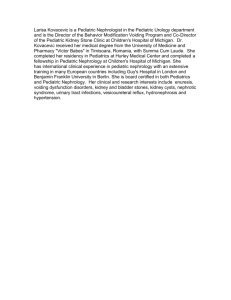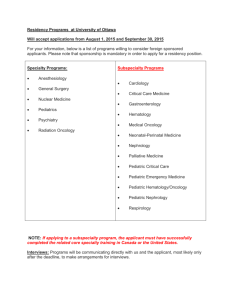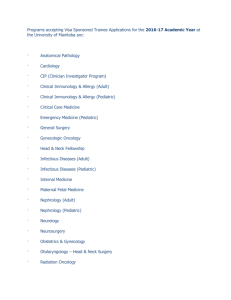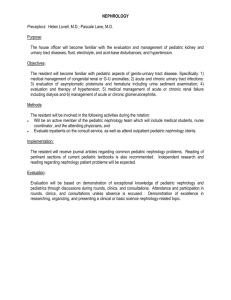Cooperation with developing countries: the example of Nicaragua
advertisement
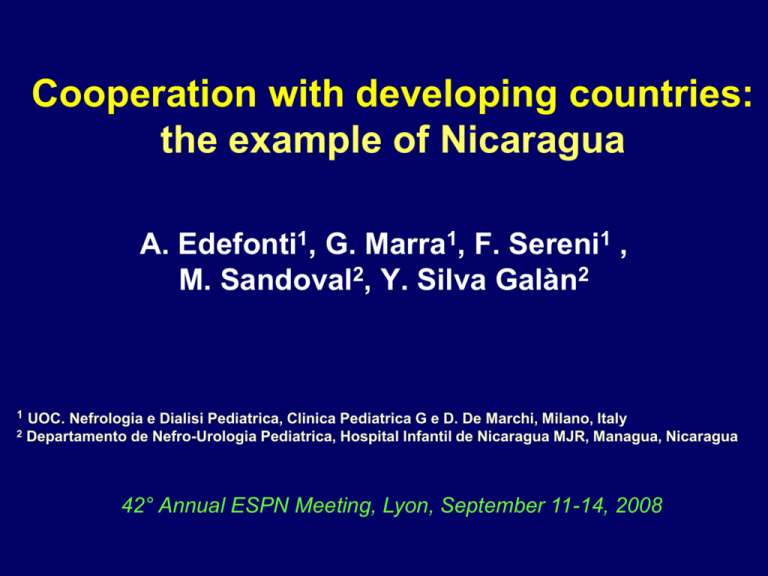
Cooperation with developing countries: the example of Nicaragua A. Edefonti1, G. Marra1, F. Sereni1 , M. Sandoval2, Y. Silva Galàn2 1 2 UOC. Nefrologia e Dialisi Pediatrica, Clinica Pediatrica G e D. De Marchi, Milano, Italy Departamento de Nefro-Urologia Pediatrica, Hospital Infantil de Nicaragua MJR, Managua, Nicaragua 42° Annual ESPN Meeting, Lyon, September 11-14, 2008 Introduction • No specific pediatric workshop dedicated so far to the initiatives of cooperation, but increased awareness of the matter • ISN organizing a COMGAN workshop during WCN, Milan 2009 • Pediatric contributions in the literature about the epidemiology of renal diseases in the developing countries, but not about models of cooperation (Cont.) • Pediatric Nephrologists always open to educational matters (courses, stages for doctors of developing countries) • ESPN members regularly receiving trainees from abroad and developing differents types of projects • No systematic documentation so far of the initiatives of pediatric cooperation worldwide – IPNA Fellowship Committee starting to require feed-back and track doctors receiving educational grants A provocative question Is cooperation with developing countries only an educational (teaching /training) issue? The start of the cooperation with the Pediatric Nephrology Unit of Managua • 1997-1999 Stage in Milano of Dr. Mabel Sandoval Dìaz • 1999-2000 Complain about lack of tools to properly diagnose and treat renal diseases in the Nicaraguan Hospitals • 2000 Visit to Nicaragua of Italian pediatric nephrologists and recognition of the paucity of human, instrumental and economic resources at Hospital Infantil MJR • 2001 Start of the project of cooperation, financed initially by the Associazione per il Bambino Nefropatico, Milano Topics • Methodology of the project • Results of the project – Clinical activity – Epidemiology • Points of discussion Nicaraguan demographic indicators Total Population 5 142 098 Child Population 2 514 144 Child mortality 36/1000 Annual per capita income $ 730 Life expectancy Male 67.0 years Female 71.0 years www.inec.gob.ni Censo de Poblaciòn 2005. Characteristics of the initial project 1. Free of charge basic assistance for children with renal diseases • Lab test, drugs, imaging (in the private system, whenever necessary) 2. Establishing shared nephrological protocols for the main kidney and UT diseases (the 10 clinical syndromes) 3. Establishing a Pediatric Nephrology Unit in a public Children University Hospital in Managua • • Scaled training in Milano of the different components of the team, (Pediatric Nephrologists, Urologists, Imaging specialist, Pathologists, Dialysis Nurse) Building a new Pediatric Nephrology ward Characteristics of the initial project 4. 5. Implementation of a database • to gather data on the epidemiology of renal diseases (with special regard to CKD) • to record and monitor clinical activity • to make quality control of the diagnoses Web connection between Milano and Managua for clinical consultation Expansion of the initial project 1. Start of a RRT program (2 beds for HD, CAPD and 6 living donor Tx per year) for selected children with ESRD 2. Establishing a Pediatric Nephrology Network including 5 District Hospitals covering about 55% of the Nicaraguan population - to increase diagnostic and therapeutic power in each hospital (supply of lab test, medications, imaging tools, shared protocols) - to avoid patient and family unnecessary transfer to Managua, whenever possible Expansion of the initial project 3. Proposal of the model of cooperation to other Central America countries • Sharing database with Guatemala • Conference on the Prevention and Management of CKD in five Central America countries (29th of February 2008) 4. Extension of the project to a 6th District Hospital where CKD prevalence is allegedly high (61% of population covered) 5. Project of early diagnosis and treatment of kidney and UT diseases in the peripheral “Unidades de Salud” depending from the 6 District Hospitals The Pediatric Nephrology Network in Nicaragua at September 1 st 2008 León Jinotega Chinandega Managua Milano Matagalpa Masaya Granada Chronology of the project of cooperation 2001 Basic assistance Protocols/guidelines Team training Database Web connection MI – MA Infrastructure Dialysis and Renal Transplantation Network of 5 District Hospitals Database shared with Guatemala Central America conference on CKD Extension to a 6th District Hospitals Extension to territorial “Unidades de Salud 2002 2003 2004 2005 2006 2007 2008 Funding of the cooperation project (2001-2008) Private Foundations Public Grants Associazione per il Bambino Nefropatico, Milano (2001-2008) Health Ministry of Regione Lombardia (2004-2008) Asociación para Niños Nefropáticos, Managua (2004-2008) IPNA Educational Grant (2008) € 600 000 € 550 000 Funds from Nicaraguan Health Ministry • Salaries for 4 Pediatric Nephrologists, 2 Urologists, 1 Pathologist, 11 Nurses, 1 part time Dietician and 1 Psychologist in Managua and 6 Pediatricians of District Hospitals • Costs of hospitalization, essential medications, lab test and imaging • Costs of Peritoneal Dialysis, (CAPD and APD) in Managua • Cost of immunosuppressive medications for renal transplant in Managua since 2008 Topics • Methodology of the project • Results of the project – Clinical activity – Epidemiology • Points of discussion Clinical activity of the Pediatric Nephrology Unit of HINMJR during the year 2007 Number of hospitalizations Number of outpatient visits – Nephrology – Urology Number of renal biopsies Number of urodynamic tests 818 3096 1842 29 61 Clinical activity of the Pediatric Nephrology Unit of HINMJR at 31 th of December 2007 Number of children with CRI/ESRD Number of children treated with chronic HD Number of children treated with PD Number of transplanted children • 2004 – 2007 • 2008 166 13 9 17 14 3 Cumulative number of children with kidney and UT diseases entered in the database Pediatric Nephrology Unit of HINMJR (2002 – 2007) 2019 patients 2500 2000 1500 1000 500 0 2 200 3 200 4 200 5 200 6 200 7 200 Cumulative number of children with kidney and UT diseases entered in the database District Hospitals (2005 – 2007) 858 patients 300 250 200 Granada Jinotega Masaya Leon Matagalpa Managua 150 100 50 june-05 sept-05 dic-05 mar-05 june-06 sept-06 dic-06 mar-07 june-07 sept-07 dic-07 Main diagnoses of kidney and UT diseases in Nicaragua Pediatric Nephrology Unit of HINMJR (2002 – 2007) 2019 patients 500 450 400 350 300 250 200 150 100 50 0 P A N SG SS S N ic en g ro eu N r de ad l b bs O ro U t. p U TI D N s ia th i L is S N SR V U id K R y ne h as pl o yp ia r ic M at m e oh ia ur Lu s pu is it hr p ne s er th O Main diagnoses of kidney and UT diseases in Nicaragua 5 District Hospitals (2005 – 2007) 858 patients 400 350 300 250 200 150 100 50 In s sis Lit hia uf fic ien cy Ur op Re na l Ob st . s op at ie ep hr Ot he rn ro tic sy n do me UT I Ne ph AP SG N 0 Epidemiology of CRI in Nicaragua Nicaragua Italy * Point Prevalence (patients/pmpp) 36,4 74,7 Incidence (patients/pmpp) 9,8 12,1 Incidence in the period 2002 - 2007 16,0 14,0 12,0 10,0 8,0 6,0 4,0 2,0 0,0 2002 2003 2004 2005 2006 2007 * Ardissino GL. et al. Epidemiology of chronic renal failure in children data from ITALKID project (2003) Pediatrics 111;4:382-387 Primary renal diseases causing CRI at HINJMR (2002 – 2007) 166 patients 500 450 400 350 GFR:≤90ml/min/1,73 300 250 200 150 100 50 rs e O th is ri t h us p Lu yp h ey n id N ep op V U la si a R S R N S th ia si s N D ro p .U st O b Li K N e ur og en ic b A la d de P SG r N 0 Prevalence of CRI (patients/pmp) in the Nicaraguan Districts 210 Districts inside the project Districts outside the project 150 120 90 60 30 Nu Se go vi a Ji no te ga ev a on t al es RS J Ch Ri va s in an de ga M at ag al pa Ca ra zo Ch ac o Bo A ra na da G RA M as ay a Es te lí M an ag ua 0 Le ón prevalencia pmp 180 Follow-up of patients with CRI CRI 166 Deceased 67 * Without RRT 54 Lost to follow-up 41 CRI 32 On RRT 13 On follow-up 58 PD 5 HD 7 Tx 14 * Medical decision 27 % Family decision 48 % (socioeconomic reasons) Deceased before the onset of the RRT program 25 % Topics • Methodology of the project • Results of the project – Clinical activity – Epidemiology • Points of discussion Points of Discussion • The problem of allocation of financial resources to pediatric subspecialties by Health Ministries of developing countries - Low budget expected - More for primary care than for tertiary care • Top-down model (development of a central unit prior to peripheral hospitals) preferable for pediatric subspecialties? • Financial feasibility of the assistance to CKD/ESRD in a developing country and scaled transfer of the costs to the government Points of Discussion • Need for fund-raising programs from private and public institutions to finance a cooperation project • Role of data-bases to assess and monitor the efficacy of a project and to allocate financial resources • Ethical issues, like allocation of financial resources to dialysis/Tx vs prevention programs of CKD or selection criteria for patients in need for RRT • Extension of the cooperation model to other countries (methodological aid instead of financial aid) A provocative question Is Cooperation with developing countries only an educational (teaching/training) issue? No. There’s something more to do than just giving the instructions to catch the fish You should provide also (at least one) fishing rod What is the fishing rod? • Experience in the development and management of a Pediatric Nephrology Unit and Pediatric Nephrology Network • Financial resources, through fund-raising programs, both in the developing and industrialized countries • Experience in scientific communication What about scientific communication? • Need for discussing models of cooperation and confronting different experiences • Need for spreading a culture of cooperation among pediatric nephrologists Dedicated workshops? Publications in pediatric journals? Internet? Registry? Life is calling. How far will you go? Thanks
